
“Cube”. There is something gratifying to the opening of the 1997 Canadian film where the hapless prisoner is caught in a grid of razor wire and literally falls to pieces. The fact that a gory set piece such as that could be followed by a psychological thriller with the feel of a good “Twilight Zone” episode is a small wonder and helped to cement “Cube” as a cult hit. However, sensing the film*s loyal following, a cheap straight to video sequel was hobbled together possessing none of the flair or brains of the original, using instead repetition and sub par digital effects. When it was announced that a third “Cube” film would be made, a prequel in fact, most of the fans of the original had good reason to be skeptical given the abomination that was the second entry. In fact how could a sequel/prequel ever match the original? Since the first “Cube” was based upon elaborate death traps and motivation of the characters what could a follow up film do but shamelessly repeat these themes unless it tried to do something completely different. Which is almost exactly what “Cube Zero” aims to do.
Is it as good as “Cube”? Noooooooo. Is it better than “Cube 2: Hypercube”? Yes, much better. “Cube Zero” deals with Eric Wynn, a lower level employee, who helps run the cube deathtrap. While morbidly fascinated with his job Wynn is driven to take a stand against his employers when he finds himself attracted to Cassandra (Stephanie Moore), one of the prisoners. “Cube Zero” has two faces, the first is Wynn in his dull job helping to monitor the Cube. His questions regarding why it exists and the bureaucracy he encounters is downright Kafkaesque. The look and feel of the complex he works in is more retro 1930’s than futuristic and paints a different picture of those who run the cube than was alluded to in the previous films. However while the sections with Wynn are offbeat and miles away from the other films the sections dealing with Cassandra as she and other survivors make their way through the cube are extremely similar to the first two installments. The same brand of infighting surfaces and these characters are drawn very broadly to the point that the audience wishes that they will just fall into a new trap (which they do). Thankfully most of the film focuses upon Wynn and the more unoriginal segments from within the cube are complemented with innovative new set pieces involving acid, plague and death by sound.
“Cube Zero” is quite uneven, slamming two very different types of stories together, and yet should be commended for trying something new. While far from the success the original was “Cube Zero” shows that even straight to video sequels can provide surprises and hopefully if any more “Cube” installments are made they are able to follow this trend.

